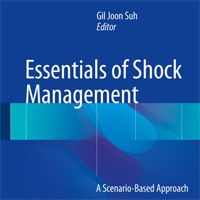Tag: hemorrhagic shock
Noninvasive Monitoring of Changes in Cerebral Hemodynamics During Prolonged Field Care for Hemorrhagic Shock and Hypoxia-Induced Injuries With Portable Diffuse Optical Sensors
There is a consistency in blood flow measures in both injury mechanisms (hemorrhagic shock and hypoxia), which is significant as the new prototype system provides similar measures and trends for each brain injury type, suggesting... read more
Essentials of Shock Management: A Scenario-Based Approach
This book is designed to offer the reader first-rate guidance on shock management in the real world. Comprehensive, evidence-based, and up-to-date instruction is provided on optimal care of patients with different types of... read more

Resuscitation with Blood Products in Patients with Trauma-related Hemorrhagic Shock Receiving Prehospital Care
The trial did not show that prehospital PRBC–LyoPlas resuscitation was superior to 0·9% sodium chloride for adult patients with trauma related hemorrhagic shock. Further research is required to identify the characteristics... read more
Traumatic and Ischemic Injury: Methods and Protocols
This volume focuses on procedures for the development and application of several research animal models and in vitro methods that allow researchers to gain insight into the underlying cellular, biochemical, and physiological... read more

Thrombotic and Hemorrhagic Complications in Critically Ill Patients with COVID-19
Critically ill patients with COVID-19 experience high rates of venous and arterial thrombotic complications. The rates of bleeding may be higher than previously reported and re-iterate the need for randomised trials to better... read more
The Misunderstood Coagulopathy of Liver Disease
In patients with abnormal coagulation testing results in the setting of liver disease, INR and PT may be best used to provide the practitioner with information about the synthetic function of the liver but not to assess hemorrhagic... read more
The Protective Effects of Regional Hypothermia on Injured Limbs Combined with Hemorrhagic-shock & Tourniquet
The aim of this study is to investigate the protective effects of regional hypothermia (RH) on rabbits' limbs injured by a steel-ball combined with hemorrhagic-shock, and then employed tourniquet over-time, tried to identify... read more
Use of Vasopressor Increases the Risk of Mortality in Traumatic Hemorrhagic Shock
Use of vasopressor for traumatic hemorrhagic shock was associated with mortality after controlling for biases (trauma severity; volume of fluid resuscitation). Among 236,698 trauma patients, 3,551 were included in the... read more
Prehospital Plasma during Air Medical Transport in Trauma Patients at Risk for Hemorrhagic Shock
In injured patients at risk for hemorrhagic shock, the prehospital administration of thawed plasma was safe and resulted in lower 30-day mortality and a lower median prothrombin-time ratio than standard-care resuscitation.... read more
Hemorrhagic Shock: Pearls and Pitfalls for the Resuscitation Room
Hemorrhagic shock is a state of systemic hypoperfusion secondary to acute blood loss which may have either traumatic or atraumatic etiologies. While gastrointestinal and traumatic etiologies are some of the most common causes... read more
Low-volume Resuscitation with Normal Saline is Associated with Microvascular Endothelial Dysfunction After Hemorrhage
Low-volume resuscitation with normal saline is associated with microvascular endothelial dysfunction after hemorrhage in rats, compared to colloids and balanced crystalloids. Resuscitation with NS failed to inhibit syndecan-1... read more
Systemic and Microcirculatory Effects of Blood Transfusion in Experimental Hemorrhagic Shock
The microvascular reperfusion injury after retransfusion has not been completely characterized. Specifically, the question of heterogeneity among different microvascular beds needs to be addressed. In addition, the identification... read more









